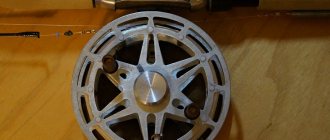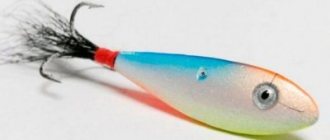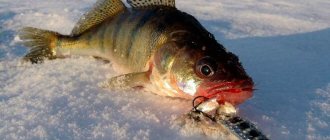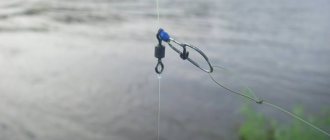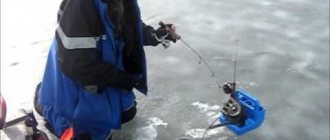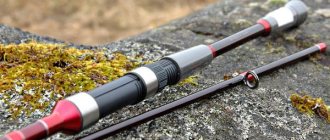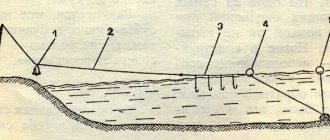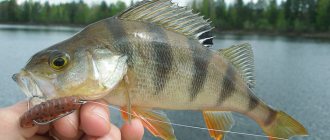Winter fishing is a great way to spend time for lovers of active recreation. Many people believe that the under-ice season is the most interesting, because there are countless fishing methods in winter; one perch can be lured out in a dozen ways. Fishing with the Balda is as popular among fans of the “striped fish” as the jig. The bait has many names: witch, bomb, eggs, bold, etc. For winter fishing, standard fishing rods with a hard whip are used, at the end of which a nod is attached.
Design features
The appearance and play of the bully resemble a beetle swarming in the bottom, which attracts fish so much. A lead cone is used as a sinker. Since the purpose of fishing is perch, it makes no sense to use more expensive metals. At the top of the figure there is an eyelet through which a fishing line up to 0.2 mm thick is passed. Hooks are mounted on both sides; the fore-end should be long, making it easier to remove them from the fish’s mouth. Beads of any color must be attached to it, repeating the colors of various insects.
Small red balls are often used, imitating bloodworms - the main food supply of the striped predator. The sinker plays the main role in attracting it; it has an elongated shape with a flat bottom, but there are models similar to small spinners. As a rule, they are made by hand, at home. Standard bait can be bought at the store.
What kind of tackle is a “bulda”?
When fishing for perch on a bulldozer, you use a short fishing rod, the end of which is reinforced with hard material, which helps you play the bait in the right directions. A soft nod on the rod in the form of a silicone tube registers the moment when the rod touches the bottom and records the bite.
When using one tool, but at different depths of water, it is equipped with a device for winding and unwinding fishing line onto a plastic reel. You can build a boom yourself; this tackle is simple in design and does not require special skill to install the elements.
Materials are selected from household items or purchased at a retail outlet:
- the lead weight is elongated in shape, resembling a drop with a drilled hole in the narrowed part;
- 2 identical hooks placed on the sides of the sinker on the fishing line; for this, tie a loop;
- bright beads, multi-colored fragments of a plastic tube with elasticity and flexibility.
Hooks are selected smaller in size than the attached load with the points directed in different directions. The fisherman selects tackle in accordance with the parameters of the perches that live in a given reservoir; if the fish is small, a small one is attached and vice versa. Beads are strung on each hook and decorated with colored cambrics.
Experiments can be different with coating the lower part of the bulldozer in a red tint or leaving it in its original form, since the paint doesn’t last long anyway. Each master observes the preference of the perch and decides how to modify the bass. They figure out how best to attach the hooks, build a sinker that is not lead, but:
- tungsten
- bronze
- copper
https://youtu.be/Uii8Ct6MQYc
Initially, the “balda” was a vertical spoon with an additional single or double hook on a loop. Then there were two hooks - one single on each side of the spoon.
Then the spoon lost its main hook, because... it only increased the number of hooks, and the bites went to additional hooks. The next step was to replace the spoon with a weight, which began to knock on the bottom and raise mud.
General characteristics and use of the modern “balda”
To make the tackle, you need a sinker with a hole in the top, two hooks No. 15-20 with multi-colored beads or cambrics, of a classic shape with large rings. The length of the hook should be less than the length of the sinker. In the classic and simplest version of the tackle, a hook, a weight, and a hook are successively strung onto the main fishing line.
They knit a loop up to 20 cm long. It has been noticed that a loop that is too short, in addition to limiting the free movement of the flapping antennae, can increase the number of their hooks onto each other. The basic rule of assembly is symmetry in all parts, right down to the cambrics and beads on the hooks.
Recently, various variants of the “balda” have appeared:
- universal. Hooks and sinkers are placed on a piece of fishing line. The ends of the fishing line are tied to a triple swivel. The main fishing line is tied or fastened with a carabiner to the middle ring of the swivel. Having made several versions of such equipment, you can quickly replace it in any frost;
- the tackle is made using bronze, brass or copper weights. It has been noticed that such sinkers make a sound that attracts fish;
- with a ring on the upper part of the body of the rig, instead of an opening;
- with a third hook at the bottom of the load;
- with a leash and an additional hook above the load. Instead of a hook, sometimes they put a fly;
- with additional beads between hooks and weights;
- a hollow body made of non-ferrous metal, filled with balls that ring during the game;
- with flies instead of hooks;
- The body of the triangular bait is cut out of sheet lead 1 mm thick. The width of the bait at the bottom is 6-7 mm, at the top 2-3 mm. A hole is punched in the narrow part for the fishing line. Good catches include bream, perch, and large roach;
- a microbald with three hooks, comparable in size to a jig. The main thing in the manufacture of tackle is the need to create an imitation of the movement of an aquatic animal, waving its legs or antennae, which also moves in a muddy cloud at the bottom.
It is advisable to use this bait - a balda - with a fishing rod that has a rigid rod, because the bait is quite heavy. The fishing rod should not be long; a short winter version of the tackle is absolutely suitable here.
The bulldozer itself has a simple device:
- sinker (drop-shaped, spindle-shaped);
- two hooks (optional single);
- cambrics, beads for greater attraction of perch.
Advantages
Such a spoon certainly has a number of advantages compared to other artificial baits.
These are the benefits:
- Because of its weight, the bulldozer quickly rushes down to the bottom. It is not hampered by accumulated pieces of ice or the river current, even if it is strong. Under any circumstances, this bait sinks to the bottom, and you can start working with it.
- The use of a sinker spinner is possible without additional feed attachments. It is a self-sufficient bait in itself. The fish's interest in such a lure is due to its bright design due to beads, cambrics, as well as the “cloudy” action of the bait.
- It’s easy to make a sinker-sink yourself, so you can do without a purchased option.
Flaws
Fishing technique and tactics
Fishing on the Balda in winter repeats the art of trolling. Plumb fishing involves characteristic swings of the rod with a short pause. Unlike a spinner, which floats in the water column, a bulldozer catches fish from the bottom. It received its name in honor of the blacksmith's hammer. The impact with the bottom and the billowing cloud of turbidity are reminiscent of the actions of a craftsman. To understand how to fish with a balda, you should make a series of holes every 3-5 m, and then check the holes for the presence of fish. There is no point in lingering at one point for a long time, since the active perch manifests itself on the first three trips.
To learn more:
Making foam rubber bait in the shape of a fish
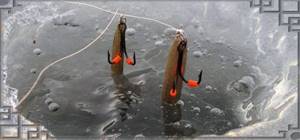
After the bait hits the bottom, the line should remain in tension. Hooks floating along the ring of the fishing line need time to sink to the sinker. All bites occur at this moment. When the perch is found, it is necessary to drill 4 more holes around the catch hole, thus creating the famous fishing envelope. To attract trophies from the nearest water area and keep them at the fishing point, bloodworms are used as feeding. It should be lowered into the hole manually, without special feeders, because fishing is carried out at shallow depths.
How does this bait work?
Perch fishing has proven to be good in places clogged with snags, where it is impossible to use a spoon.
The method with this bait has the following positive aspects:
- Since the load is endowed with a certain weight, which pulls the bait down, it easily reaches the limit and does not cling to the edges.
- The depth of the river and its current do not affect the bulldozer; it achieves its purpose of attracting attention.
- For bait, you do not need to waste time on the bait, since its hooks are lowered with decoration; they stimulate the appetite of the perches by simulating food with their movement.
- Lightly tapping the cannon on the ground gets the perches excited and they become active.
Whatever fish falls for this eccentric bait, the bulldozer is considered to be aimed only at perch, regardless of whether it is coastal or deep. To regulate fishing, use a weight to reduce or decrease its mass.
This tackle consists of an elongated sliding sinker, with 2 hooks attached to one line. Pieces of colored cambric, beads or any other objects that shine attractively in the water or are brightly colored are installed on the shank of the hooks to attract fish.
This is a classic type of balda, which in different regions of the country can be slightly modified and have a larger number of hooks, or differ from the classic balda by the presence of additional leashes with hooks.
You can buy a bait for little money, but it is not at all difficult to make such a bait at home. It will take very little time and effort, and the result usually exceeds all the most optimistic expectations.
Finding perch in winter
The first ice is considered the most productive time of the cold season. Several weeks after the water becomes solid are characterized by an excellent fish bite. Perch can be caught equally with both a jig and a balda. The search should be carried out immediately upon entering the ice surface.
The predator lives in shallow water, where there is a good food supply in the form of fry and other small underwater inhabitants. You can catch a fish from the very first hole. As a rule, small individuals bite near the reeds, and a little deeper you can find a worthy rival.
In the dead of winter, catching perch on a balda is not so effective, and the master has to work hard to find a trophy. Constant search is the right tactic that bears fruit. Coastal edges, reed edges, fallen vegetation, snags - these places require careful study. Interesting fishing also occurs during the thaw and at the end of February, when the ice begins to melt, triggering natural biological processes. Catching fish on a bulldozer is a simple and exciting activity.
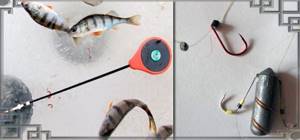
We catch perch, pike perch and bream on Baldu
The bait, which at first glance bears the dissonant name “bulda”, has been known for a long time. However, despite the name, this tackle shows outstanding results in both the winter and summer seasons.
Baldu fishing is popular in the European part, Siberia, and the Far East.
…
Varieties of bullda
A study of various sources allows us to assert that the balda is called not only the tackle itself, but also a fishing method that uses complex composite tackle.
Conventionally, fishing on the bulldozer can be divided into several groups:
- The classic bullhead is known to most winter anglers. This tackle is a drop-shaped sinker, truncated at the top and having a through hole through which a loop of fishing line is passed. Two hooks are attached to the loop, decorated either with beads, or colored cambric, or an artificial fly. Some shares are equipped with rings soldered into the upper part, to which hooks are attached. Such baits come in different sizes, different weights, and with different hooks. Sinkers are most often made of lead, but there are small varieties made of tungsten alloy.
- On the rivers of Siberia, a balda is a tackle consisting of several parts. As the lower bottom part, either a classic boom or a pear-shaped or elongated sinker is used, then there is a so-called setup or post - a piece of fishing line with two or three leashes equipped with flies or hooks with beads. Through the carbine, the set is connected to the main fishing line, on which there is a powerful float, which can also be called a float or float. The float ensures that the tackle moves with the current and signals a bite, and the correctly selected depth allows you to “tap” the bottom with a sinker or a classic boom.
- To catch grayling in Siberia, they use a very interesting tackle, which is also called a balda, although it has fundamental differences in that fishing is carried out not at the bottom, but at the surface. The large float (balda) has a composite structure: the main body is made of wood or foam, and the bottom is loaded with lead. A tackle with two leashes of different lengths, equipped with flies for surface fishing, is attached to the float. Such a bait is floated downstream and care is taken to ensure that the bait is constantly at the surface of the water. This kind of gear is also called riding gear.
As can be seen from the above, fishing on the bulldozer combines a large number of gear and methods, each of which is interesting in its own way.
Are you interested in catching catfish with a frog? Our article will tell you and show you more about this.
Here you will find out how the sport fishing competition took place in Chernyakhovsk.
Fishing on the Baldu
In most cases, this method of fishing is bottom and winter. A classic bait of the required size with selected artificial baits is lowered to the bottom. The hooks rise to the top. Hitting the bottom, the bulldozer raises a cloud of turbidity, and the hooks begin to move downwards, thereby imitating the movement of the larva. The cambric, beads or fly on the hooks make their movements smooth, which, firstly, does not alarm the fish, and secondly, obliges them to pause after hitting the bottom so that the hooks have time to return down. Attractive to fish is the mud raised from the bottom, as well as the movement of the hook legs, which the bait waves up and down “like a bulldozer.” Naturally, such a bait will work well only on a muddy bottom and worse on a sandy bottom. Fishing with a cannon on the rocks does not give noticeable results.
In the summer, fishing with a balda is carried out with the second and third varieties of this tackle, but with classic bait, perch is also successfully caught using long rods from the shore or a boat on lakes and rivers.
This tackle is so versatile that many more interesting ways to use it will appear.
We present to you a video on fishing for balda in the summer.
Perch fishing
Before you go fishing, you need to stock up on a good collection of various baits: flies, flies, hooks with beads and cambric. It's better to prepare everything at home in advance. It is very good to have some supply of jig with you, which will be useful in order to keep the hole active.
Fishing for perch on the balda is effective starting from the first ice. In the dead of winter, the fish are inactive, so in addition to the bullhead above, you can tie a jig with a live bloodworm on a short leash. Fishing tactics are usual: holes are made in promising places, then the tackle is prepared.
It is better to use a fishing rod with a hard tip - for better hooking and a relatively soft nod made of silicone, so as not to miss a bite. The reel should preferably have a large diameter in order to quickly reel in the tackle when moving from hole to hole.
To quickly change the boom on the main line, it is better to tie a swivel with a clasp, and prepare the boom itself on a leash in advance.
Metal leashes do not make sense, as they negate the game, so if a pike bites, then you can part with the bait.
In the selected hole, first find the bottom with tackle, reel in the fishing line and fix the reel. In the future, you need to hammer the canopy a little along the bottom, raising muddy clouds, which will attract different fish, including perch. After the blow, a pause of 3-4 seconds is given, then a rise of 5-10 cm and again a pause. If there is no bite, you should change bait. If this does not help, then change the hole.
As soon as the desired bait is found, very intense fishing immediately begins, from which you should not be distracted under any circumstances, as the hole may stop working. From time to time you need to throw a handful of jig into the hole to prolong its operation. Perch is a schooling fish, so the holes can work for a long time.
This article will show the basic techniques for catching flounder in the Primorye region.
In this article you will learn how to catch pike perch on the famous path.
Pike perch on the bald
In addition to perch, you can also catch pike perch on the Balda. It happens that he is caught along with a perch. First of all, you need to find places where pike perch stand, and these are deeper places, holes, ravines, snags. You can also take a larger balda, but with a more elongated sinker. The fishing tactics are almost the same as for perch: hammer along the bottom, attract fish, and then lower, pause for a few seconds and rise to a height greater than for perch, 15-25 cm.
If the perch grabs the bait most often during a pause, then the pike perch can take it during the fall. The bite may not be noticed, so full control over the tackle is simply necessary.
Some fishermen use a good technique: after the pike perch is excited by the pike perch, which can be felt by timid bites as it falls, a pike perch spoon is lowered into the hole.
The predator cannot tolerate such “disgrace” and grabs the spoon. Therefore, do not be afraid to experiment. Fishing for pike perch on a pike can be combined with other types of winter fishing for this fish.
Bream fishing
First of all, you need to know where the bream are located in the pond. From the usual summer thickets, this fish moves to deeper places, and not into holes, but into places where there is a difference in depth. This is where he is most likely to be found. To do this, you need to know the topography of the bottom of the reservoir, and if you lack knowledge, measure it personally with a depth gauge or echo sounder.
Bream is a picky fish and loves feeding, and the best of them is bloodworms. It is highly recommended to put bloodworms on hooks - this greatly enlivens fishing. If the depth is shallow, then the fertilizer is simply thrown into the hole, but at greater depths the feeder will come in handy. Bream has a rather high body, so the hole should be wider than for perch and pike perch.
If a bream is hooked, then at first it walks calmly, but as soon as it notices the light, it begins to move to the side, making jerks. Therefore, its fishing must be careful.
Bream most often grab the bait during a pause, when the bait lies on the bottom. Therefore, you must be prepared to make a sweep while the nod is arching upward.
After the first bream is caught, the hole is immediately fed and fishing continues. If the hole is “silent”, then move on to another pre-fed hole.
Let's summarize:
- Fishing on the Balda combines many tackles, baits and several methods. This is a sporting type of fishing that is constantly developing and improving;
- You can catch many species of fish that live in various bodies of water in both the winter and summer seasons;
- When fishing with balda, those fishermen who are not afraid to experiment with gear and bait get good results.
Happy fishing!
Are you interested in catching mullet with a bombard? Read about this in our article.
Here you will learn how to catch pelengas correctly.
In this section https://lovisam.net/vidy-lovli/poplavochnaya you will find information about fishing with a float rod.
lovisam.net
Fishing in summer
The equipment and fishing principle do not differ significantly from winter gear. Using a boat, you can successfully use the boom in open water. Shore fishing requires a long rod, no shorter than 5 m. The diameter of the fishing line is taken a little larger, since the summer predator is more active and provides decent resistance. A lateral nod serves as a bite signal. The fisherman methodically fishes the coastal waters, moving from point to point. With appropriate experience, the amount of prey caught is not inferior to the winter catch.
A characteristic feature of the bulldozer is the decent size of the trophies. For catching small perch, a jig is more effective, because a large bait attracts a heavy predator, which is less abundant in the reservoir.
Foam fish on a jig head
This option is good when the range of a foam fish is not important. Open hook and non-hook possible.
- Jig head;
- High-quality medium-sized hook;
- Sinker;
- Foam rubber;
- Scissors;
- Glue.
- We cut out a bait blank from foam rubber.
- Using a blade, cut the foam rubber to the middle, with a depth to the middle of the fish.
- A sinker and a jig head are inserted into the cut close to it.
- The cut is treated with glue and pressed tightly for a few seconds.
And here's what you need to know: Basics of feeder fishing in rivers for beginner anglers. Part 5. Tactics and technique of feeder fishing
The non-hooking device is made as follows:
- A paper clip is used to make a hook that is attached to a ring on the jig head. A hook on the jig head attaches to it to keep it in a fixed position.
- A bait blank is cut out of foam rubber, and a vertical through cut is made in its head part. A crocheted paperclip is inserted into it and filled with glue.
- For the hook you need a shallow cut into which the hook is inserted and filled with glue.
Catching zander from a boat
The right time for such an action is autumn. As you know, pike perch begins to actively peck when it gets colder. An interesting way to catch it is fishing with a bullhead. When the water cools, fishermen set out on boats in search of the “fanged one.” The gear must be set up in advance so as not to waste precious time. For vertical fishing you will need a side rod up to a meter long. As a guard, a nod is mounted on the end of the whip. The pike perch bait differs from the perch model. The metal for the sinker must be heavier in order to give a ringing blow. Tungsten is better suited for these purposes, whose only drawback is the price.
To learn more:
The best wobblers for catching chub
You can fish both in still waters and on the current. The method is popular on large rivers - Don, Ural or Volga. In small rivers of Bashkiria it is also used for grayling. Along with vertical lures, catching pike perch or pike perch on a pole from a boat brings good results. It is more specialized, so other fish are rarely present in the bycatch. Single catches may include pike, and peaceful ones may include roach.
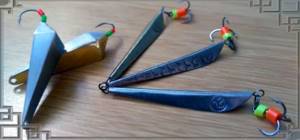
How to fish with balda in summer
Fishing with a balda in the summer is in many ways reminiscent of winter fishing with baitless jigs, but not one to one, if we talk about the methods of playing with bait, but only with the appearance of the so-called “balda”. There is something in common with both the “goat” and the “devil” in this strange bait. And how do small perches dare to grab such a large pseudo-jig? Nevertheless, this simple and amazing-looking bait can bring as prey not only palm-sized perch, but also quite weighty humpback whales, pike, and pike perch. Not one of these predators will refuse a bulldozer if it is offered to them, as they say, at the right time and in the right place...
The balda is made from a wide variety of materials, where lead ingots cast in a mold or simply in a sand pit are used as the main rod, as well as sections of rods of various metals: copper, brass, tungsten and other heavy and shiny metals. Sometimes they use bullets from small-caliber rifles and pistols. A hole is drilled in the upper part through which a fishing line or a metal leash will be passed, to which two hooks with a long shank are loosely attached. These hooks are located along the body of the bait. One of them is usually strung with beads, cambrics and other active elements of the bait. But both hooks are also active elements, to whose non-synchronous movements the fish responds well. Non-synchronization is achieved by the fact that only one hook has a set of cambrics, washers and beads. When the bait is lifted and dropped to the bottom, all these active parts begin to move, adding additional game elements to the moving main part. You just have to take into account that the bullhead is bait for a good bite. A sluggish and well-fed predator can ignore this baitless bait and grab the bait or hook with bait.
As in the winter, they catch fish on the Baldu in the summer using the method of vertical or vertical trolling. If we talk about coastal fishing, then long, seven-meter, lightweight rods with a fairly rigid fast action are used for fishing. There are, of course, some advantages to whip-like soft rods when the tip itself plays out the rise and fall of the rod to the bottom. But fishing with such a rod is somewhat difficult, especially if it is caught by a large fish. Since the line is dropped vertically from the tip of the rod, its length corresponds to the depth at the fishing site, and this can only be about one and a half meters, where the perch is kept at the edge of the coastal grass. Therefore, after biting and hooking, it is necessary to discard a certain amount of fishing line so that its length reaches the length of the rod. Only in this case is normal fishing possible.
The fishing technique is simple and consists mainly of smooth rises and drops of the bulldozer to the bottom. Short twitches are also used, reminiscent of the game of a jig. That’s why a fast-action rod will be more convenient, as it allows you to guide the bait more sensitively, that is, control it better and feel the bite better.
Fishing for bullfish in the summer is often more successful if you fish from a boat. Larger specimens are found, and in addition to perch, other predators can take them: pike perch, bersh, pike. But, given that pike perch and bersha have recently been greatly spoiled by replanting sprat, you will also have to replant cut sprat or bleak on the bald. Only then will the result be more predictable and successful.
For fishing from a boat, a short one-handed spinning rod with or without a nod, whichever is more convenient and beautiful, is best suited. The fishing technique is also not much different from coastal fishing. The same throws of the fishing rod up and drops of the bait to the bottom. Sometimes you can use raising the bait upward with short stops, as well as a smooth lowering, where you can knock the bait on the bottom and make a fuss, raising clouds of turbidity, which resembles a crawling bug or larva.
The big advantage of fishing with a boat from a boat is that, while rafting along a river or downwind on a reservoir, you can fish various promising areas of the reservoir. To reduce the speed of the boat in strong winds, they install a water brake or a sail, which is a square of tarpaulin or durable film on a metal frame. When thrown overboard, this brake, filled with water and creating a lot of resistance, slows down the speed much and allows you to calmly fish with a vertical lure on the bulldozer.
minnow.ru
Making a do-it-yourself bulldozer
Store-bought baits are made according to manufacturers' standards. However, they are not always as catchy as their homemade counterparts. The fisherman who produces winter lures puts not only skill, but also experience and soul into them.
Balda for perch
The shape and size of the sinker are set individually by each master. Lead is most often used for casting because it is cheap and has a low melting point. For production you will need:
- Shape: aluminum or alabaster.
- Hooks number 5-6. The model should have a long shank, the beard should be ground off halfway so that the beads fit correctly and do not get stuck.
- Lead. The metal is melted in a special vessel or spoon.
- Cambrics. Secure the beads to the hook and prevent them from slipping off. Winding a thin wire will also work.
- Beads of different colors.
The color of the sinker does not matter, since it attracts fish by hitting the bottom, and not by external parameters. The center of the predator's attack should be on the hook, which is equipped with colored beads to be visible and resemble a larva.
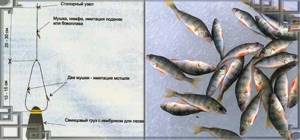
Silicone baits
Pike perch is a predatory fish, so the priority in preparing bait is the preparation of live bait, insects and other products of animal and plant origin.
Plant and animal baits
If it is not possible to obtain animal bait, then pike perch can be caught using the following baits of plant origin:
- steamed peas;
- millet porridge;
- canned corn;
- red beans;
- pasta.
If canned products are used, then undamaged grains are selected, which are placed on a fishing hook without additional preparation. Peas and pasta are cooked until half cooked so that the bait retains its shape and stays securely on the hook for as long as possible.
In addition to millet porridge, pike perch can be caught using boiled barley groats. In both cases, the porridge is cooked until fully cooked with the obligatory addition of unrefined vegetable oil as a natural attractant.
No matter how well the vegetable baits are prepared, the use of live bait and animal products increases the likelihood of a trophy-sized pike perch being bitten several times. For catching pike perch use:
- live bait,
- salo,
- leech,
- barley meat,
- worms,
- fish gut,
- dead fish.
The advantage of silicone baits is the ability to emit an aroma that predatory fish like. Fishing for pike perch with vibrotails and twisters is effective, but only when using high-quality products made from edible rubber. Among the well-proven silicone baits are the following:
- Bugsy Shad 72.
- Tioga 100.
- Ballist 63.
- Long Johg 07.90/PA03.
- Deep Pearl 100/016.
Any bait from the presented rating can be used for catching pike perch, and in order for fishing to be as effective as possible, it is recommended to select bait of the most “delicious” colors and sizes.
Size and color of silicone baits
Wide rubber bands are not used for catching pike perch. Even trophy-sized fish can be caught using a vibrating tail about 5 cm long.
The main criterion for selecting rubber baits, as well as other artificial products for catching this fish, is their small thickness. Despite the predominance of amber color in the color of silicone for catching pike perch, biting can be achieved by using brighter and sharper colors, especially in muddy water.
To determine what color of bait the pike perch particularly likes on a particular body of water, it is recommended to carry out a series of casts with baits of different colors.
How to choose the right silicone bait
To choose a rubber bait for catching pike perch, you should pay attention to the following points when making a purchase:
- No air bubbles in silicone.
- Good stretch.
- No glued parts.
If the vibrotail meets these requirements, then you can buy the product and go with it to the nearest body of water to catch pike perch.
Foam rubber is a soft polyurethane foam that is 90% air. In the national economy, it is used as insulation, sealant or insulation. Fishermen paid attention to it because, once in the water, the fish from it have positive buoyancy and acquire mobility that realistically imitates the behavior of fry.
This is a huge group of baits made from soft, inexpensive material. There are various forms of silicone, the catchability of which has been tested by time and by many anglers. Twisters and vibrotails are considered classic, while worms, crayfish and other “mackers” are more original and narrowly targeted.
It should be noted that foam fish, the production of which is described below, are in no way inferior to factory ones and are equally well suited for catching pike, perch, and pike perch.
The piece of foam rubber from which the fish is cut should be 7-10 mm thick. Using a regular thin marker or pen, draw the outline of the future bait on the material; it should be from 8 to 10 cm in length.
After this, the workpiece is cut out with very sharp scissors. To make cutting the foam easier, press it with your fingers along the contour of the pattern.
Then, using a razor blade, you need to cut off all the sharp corners from the fish to give it a rounded shape. In this case, it is very important to maintain the proportions of the bait: the body should be 3-5 mm thicker than the tail part.
If you often create foam fish at home, you can prepare cardboard or metal templates - with their help it will be easier and faster to draw the outline. You can also cut the bait from a common piece of foam rubber using a regular stationery knife.
